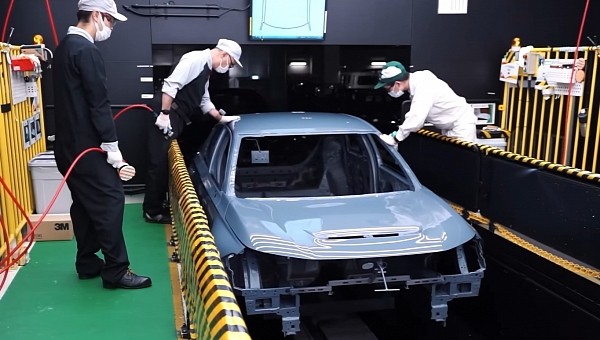Codenamed FL5, the most powerful Civic Type R yet is manufactured exclusively in Japan rather than the United Kingdom where the FK8 was produced. Not everything is made there, though. The 2.0-liter turbo four-cylinder lump, for example, comes from the Anna Engine Plant in Ohio.
The six-speed manual is made in Suzuka. These parts are then shipped to the Ogawa plant, where Honda connects the powerplant to the transmission. Regarding the vehicle, Honda assembles the 2023 model year Civic Type R alongside the Japan-spec Civic five-door hatchback.
“There were aspects of Type R’s unique specifications we couldn’t accommodate on this line,” says the narrator of the featured video. “We designed Type R-specific processes and assembly, and integrated them with the existing line.” Based on the 11th-generation Civic, the FL5 begins life with pressed panels that are then welded together to form the vehicle’s monocoque. Said welding is joined by more adhesive than used on the regular Civic, all in the name of improving rigidity.
Robots ensure that the doors, hood, and trunk lid open and close as intended. The body shell is then painted with a polyurethane top coat, which is a first for the Yorii plant. The front and rear bumpers are assembled by hand. Next up, the final vehicle assembly stage comprises the addition of powertrain, drivetrain, and suspension bits and pieces.
This stage also sees the seats going in, the gear lever and shift knob coming together, and everything else you’d expect of the final assembly. Honda mounts the wheels and tires to the car manually because existing installation equipment accommodates only non-CTR configurations.
Also worthy of note, two workers – positioned to the right and left – handle suspension assembly from start to finish. The Japanese automaker came up with this process to minimize variation. Each completed vehicle undergoes a quality inspection which includes suspension alignment.
“There were aspects of Type R’s unique specifications we couldn’t accommodate on this line,” says the narrator of the featured video. “We designed Type R-specific processes and assembly, and integrated them with the existing line.” Based on the 11th-generation Civic, the FL5 begins life with pressed panels that are then welded together to form the vehicle’s monocoque. Said welding is joined by more adhesive than used on the regular Civic, all in the name of improving rigidity.
Robots ensure that the doors, hood, and trunk lid open and close as intended. The body shell is then painted with a polyurethane top coat, which is a first for the Yorii plant. The front and rear bumpers are assembled by hand. Next up, the final vehicle assembly stage comprises the addition of powertrain, drivetrain, and suspension bits and pieces.
This stage also sees the seats going in, the gear lever and shift knob coming together, and everything else you’d expect of the final assembly. Honda mounts the wheels and tires to the car manually because existing installation equipment accommodates only non-CTR configurations.
Also worthy of note, two workers – positioned to the right and left – handle suspension assembly from start to finish. The Japanese automaker came up with this process to minimize variation. Each completed vehicle undergoes a quality inspection which includes suspension alignment.













































